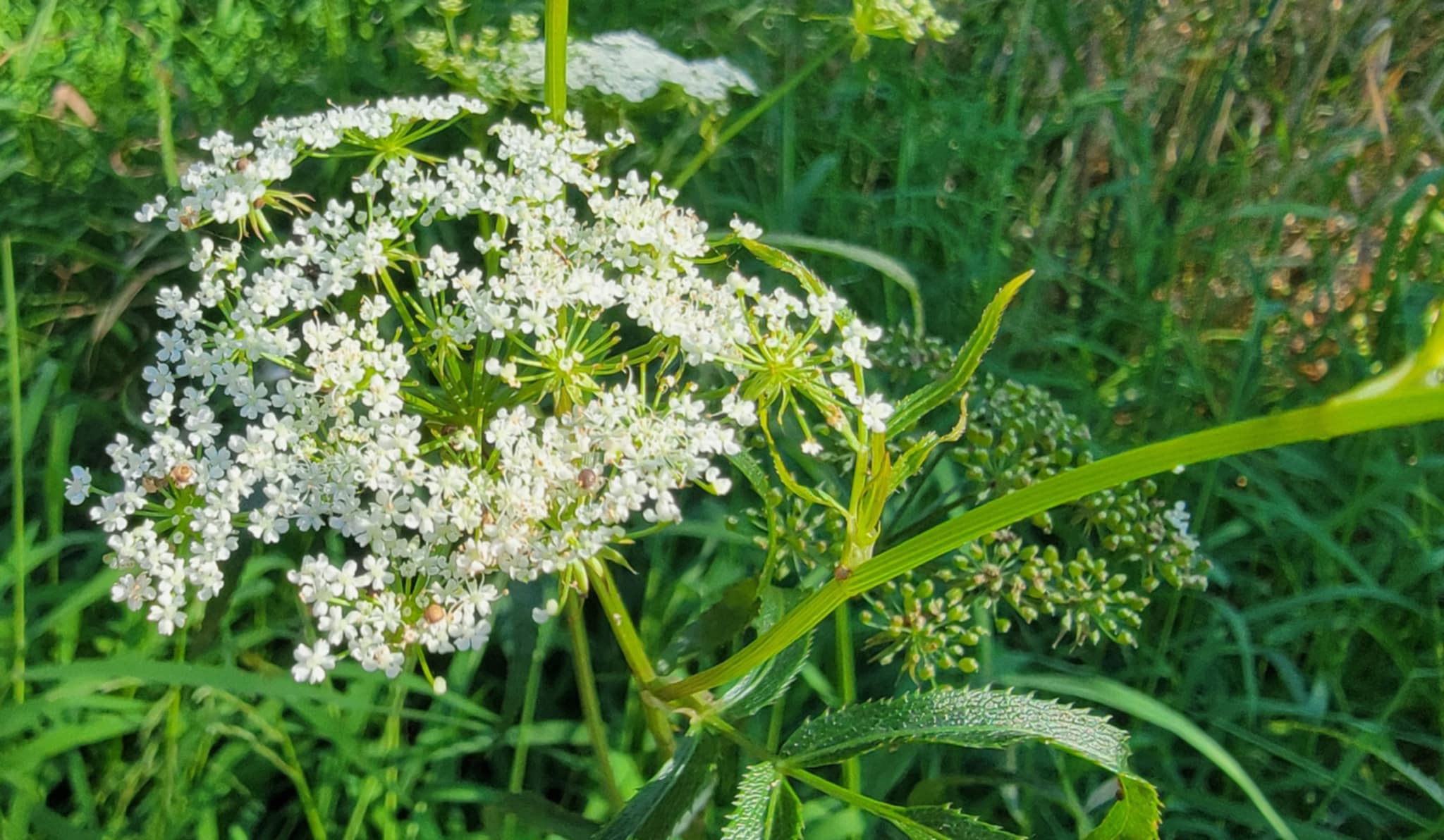Katie Byerly of Cerro Gordo County is also known as Iowa Prairie Girl on YouTube.
Tall and slender, it seemed so out of place. Water parsnip (Sium suave) grows along the edges of lakes and marshes and in wet prairies. In Wilkinson Park the prairie trails are often wet so it makes sense that water parsnip grows there. But mixed in with all the other usual prairie wildflowers at Wilkinson, like blazing stars, cinquefoils, and milkweeds, it does look misplaced.
This is an image of water parsnip in July 2018 at Wilkinson Park in Rock Falls, Iowa. I recall it being the only parsnip growing there at the time. Now at least a dozen water parsnip plants grow at this spot.

I didn’t catch the Wilkinson water parsnip in bloom this year. These two images of the spent blooms show off the umbel silhouettes on a late August evening.


Water parsnip blooms between July and September in Iowa. Minnesota Wildflowers describes the inflorescence as follows:
Convex cluster (umbel) to 5 inches across made up of groups (umbellets) of 10 to 20 flowers each. Flowers are about 1/8 inch across with 5 white petals that are somewhat heart-shaped and may be of unequal size.
The second place I observed water parnsip was at the Mallard Duck pond at McIntosh State Park in Clear Lake. It grows in the shallow, mucky, swamp water along the observation boardwalk. I was fortunate to find it still in bloom on September 1 this year. Here is an up-close image of the heart-shaped flower petals.

These images show how the umbellets spread out.


A bottom or upside down view of the umbellets. Look closely to find the curved floral bracts under the umbels.

As the flowers bloom they fill in, hiding the umbels and stems. They create a lovely, flat-topped, bouquet.


Water parsnip grows to a height between two and six feet. With its slender, long stem and slim finger-like leaves, it has a willowy appearance—especially if next to stout prairie plants. This image shows a water parsnip growing next to the bird observation shelter at Mallard Pond at McIntosh State park.

The growing environment seems to determine the shape and size of the leaves. The leaves present in leaflets, with finely toothed leaf edges.


According to the Illinois Wildflowers website, this plant in the carrot family can grow a variety of different leaves. They comment that the variability of its leaves can confuse a novice. This makes one wonder and hope that I’ve identified this plant correctly.
All sources warn not to get this native parsnip mixed up with other poisonous hemlocks. I have touched this plant without any ill results. It is not regarded as toxic to herbivores. However, its relatives are so toxic that this one comes with warnings to avoid, just in case one gets them confused.
Apparently when in shallow water, the plant has submersed feather-like basal leaves. I have seen pictures but never observed these myself. I hope someday to find water parsnip growing in water clear enough to see this variation on the leaves.
Each flower develops into a tan, ribbed seed capsule. The next image shows again the slenderness and gracefulness of this plant as the spent flower heads turn to seed.

And the brown capsules here in this picture.

The third place I’ve found water parsnip is along the boardwalk at the White Wildlife area north of Rock Falls, Iowa. Water levels at the boardwalk vary greatly from inches to dry earth. The water parsnip here rarely reaches the top of the 2-3 feet tall boardwalk; however, it does appear at home along the cattails with its sylph-like attitude.
I close with a few unique pictures I have captured of this peculiar, wetland wildflower.






1 Comment
There are several tallish white-flowered native carrot-family species in Iowa...
…and as a non-botanist, I have been confused by them before. It’s fun and interesting to see these photos and read this post, a reminder of how beautiful the plants are and why they can be confusing:-).
Expertise is absolutely necessary for good native-plant conservation. But so is public enthusiasm for native plants, expertise not required. Iowa’s native ecosystems need all the support they can get. Thank you to Iowa Prairie Girl and all the other Iowans who are encouraging native-plant enthusiasm.
PrairieFan Thu 10 Oct 2:39 PM